Boring stuff: I have visited each of the places I recommend and give you my honest opinion, warts and all. All photos are my own unless otherwise stated and may not be reproduced without permission. Affiliate links may earn a commission at no extra cost to you.
Top Belfast Mural Tours
1. Black Taxi Political Tour
2. Political Walking Tour
3. Belfast Taxi Mural Tour
4. Murals & Crumlin Road Gaol
5. Political Murals & Peacewall
One of the best things to do in Belfast is to take a walking tour to see the city’s famous Republican and Loyalist murals. There are a few different Belfast mural tours to choose from. In this article, we will look at the different options, as well as review one of these tours.
I spent an incredible three hours on a Belfast political and mural tour exploring the history of this troubled city. The tour was conducted by ex-prisoners from either side of the divide, which gave a unique insight into “the Troubles”.
Aside from the many walking tours, Belfast black cab tours are another popular way to see the city’s murals and learn about the history from a local cabbie.
- Conflicting Stories Mural Walking Tour – Book here with Get Your Guide
- Conflicting Stories Mural Taxi Tour – Book here with Get Your Guide
- Political Wall Murals and Peace Lines Tour – Book here with Get Your Guide
The Three Types of Belfast Mural Tours
- a walking tour
- a black taxi tour
- venturing off on your own
Although Belfast is a reasonably safe city, wandering around the divided estates of East and West Belfast on your own, camera in tow, might raise a few eyebrows. It is certainly not recommended to visit these areas alone after dark as trouble can and does flare up sporadically.
The best way to witness the murals is with a guided tour, and personally, I found the three-hour “Conflicting Stories” tour to be fantastic. The tour is split into two, with the first guide being an ex-prisoner on the Republican side, and the second half with a former Loyalist prisoner.
The other option is a Belfast black taxi tour. These tours take you around both Republican and Loyalist areas to see the murals and peace walls. This is an especially good option if it rains, which unfortunately Northern Ireland has more than its fair share of!
For anyone interested in so-called “dark tourism“, a Belfast mural tour is a must!
Top 5 Belfast Mural Tours
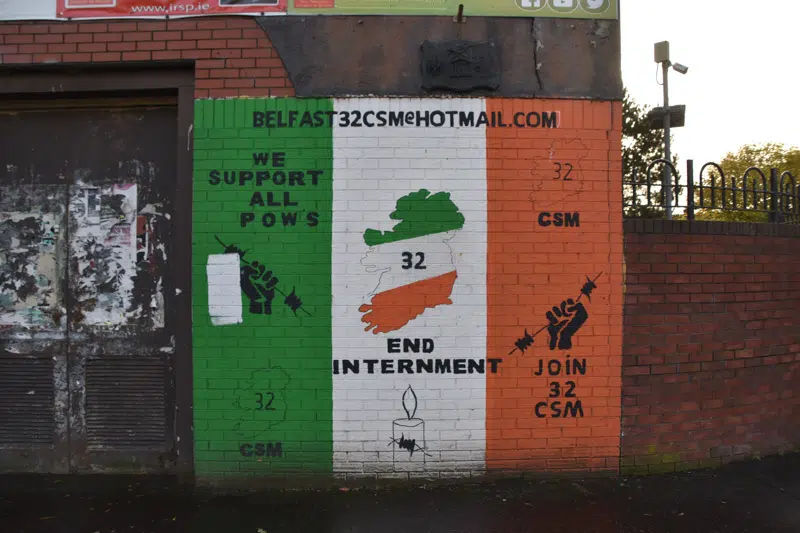
Below you’ll find a selection of the best Belfast mural tours including both walking and taxi tours. These experiences include visits to some of the most famous murals in Belfast as well as other related sights from the peace lines to Crumlin Road Gaol.
1. Black Taxi Political Tour
This one-hour guided tour with a Belfast taxi driver will take you to many of the famous murals on both sides of the divide.
You’ll learn about the history of the conflict from a local and see the peace lines as well as the Falls and Shankhill roads. Click here to book now.
2. Political Walking Tour
This three-hour political walking tour is a must for first-time visitors to Dublin to learn about the history of the Troubles. I did this tour myself and it was absolutely fascinating.
You’ll get to spend time with former prisoners from both sides of the conflict and see all the most famous murals including the Bobby Sands Mural on the Falls Road and UVF murals on the Shankhill. Click here to book now.
3. Belfast Taxi Mural Tour
This fantastic 90-minute tour will take you on a journey through both the Catholic and Protestant sides of Belfast while learning about the city’s troubled history from a local cab driver.
See the most famous murals on the Falls and Shankhill as well as the peace lines separating the two communities to this very day. Click here to book now.
4. Black Taxi and Crumlin Road Gaol Tour
This private taxi tour includes both the Catholica and Protestant murals and the peace lines.
You’ll learn a little about the conflict from a local cab driver before being dropped off at Crumlin Road Gaol for a self-guided tour of the prison where many on both sides of the conflict spent time. Click here to book now.
5. Political Murals and Peace Wall
This 90-minute tour by black taxi includes the murals of the Falls and Shankhill, the peace lines and lots of opportunities to stop for photos. You’ll learn about the Troubles from a local guide. Click here to book now.

How to Book your Belfast Mural Tour
Our partners at Get Your Guide offer a great selection of Belfast Mural Tours, from walking to taxi tours.
You can book direct on their website and you will be issued a receipt. Simply show this to your guide (they will cross-reference against your name on a list). Click here to book your tour today.
Cost of Belfast Mural Tours
The cheapest Belfast mural tour is just £23 (Conflicting Stories) up to around £60 for the Belfast Black Taxi Tour. The tours range from one hour to three hours in length.
Belfast Mural Tours are suitable for adults and those aged over 15 years old. Due to the subject matter of the tours, they are not suitable for children.
Geography of Belfast and Northern Ireland
Northern Ireland is made up of six counties in the north of the island of Ireland. These provinces are (currently) part of the United Kingdom and not part of the Republic of Ireland.
When the Republic of Ireland broke away from the United Kingdom after the 1922 War of Succession, these six counties remained part of the crown and thus partitioning Ireland.

About the Belfast Murals
The murals in Belfast, on each side of the divide, are some of the most prominent reminders of Northern Ireland’s troubled past. These murals can be seen in areas like the catholic Falls Road and protestant Shankhill Road.
Since the 1970s some 2,000 brightly-coloured paintings have appeared across Northern Ireland, with the most famous of these being located in Belfast and Derry.
These murals depict the culture, struggles and lives of each community in Northern Ireland. Some of the murals depict historical figures, sporting heroes and martyrs to each cause.
Republican Murals


The republican murals depict the Irish struggle for independence and associated figures. There are also many murals painted in solidarity with other political causes around the world from Palestine to Cuba.
There are also murals championing Irish culture, Gaelic sports and so forth.
Loyalist Murals


The loyalist murals, by contrast, show of the solidarity to the UK and celebrate “Queen and Country” as well as figures related to the struggle against the IRA and republicanism.
About the Peace Lines

The so-called Peace Lines are a series of walls and high fences separating the two communities. These walls and fences can be found across areas of the city where both communities live in close proximity.
The primary aim of the Peace Lines is to de-escalate violence and stop attacks on either community. You can see that there are distinct sections that have increased in height over time to stop the throwing of missiles and petrol bombs.
In addition to the peace lines, there are many gates that allow traffic to pass through during the day, but are closed for a curfew every night at 7pm.
Review and Personal Experience of the Conflicting Stories Political Tour
The Route
The tour starts off on Divis Street which is about 600 metres northwest of the city centre. It then continues along Divis Street onto the Falls Road to take in different murals there. From there a right turn onto Clonard Avenue to visit Father Alec Reid’s former church and an IRA memorial garden.
It’s then a short walk onto Springfield Road and onto Lanark Way and through the gates and across the Peace Lines. From Lanark, the tour turns onto Cupar Way and follows the wall until turning off onto Lawnbrook Avenue and then the Shankill Road where the tour ends.
The meeting point for the tour was outside a large tower block on Divis Street, less than a kilometre from the city centre. The first half of the tour was to be with an ex-prisoner from the Republican side, presumably a member or former member of the IRA.
Even though we were only a few hundred metres from the centre of Belfast, it was possible to see the large fence of the Peace Lines behind some houses. Republican murals depicting scenes of Gaelic sports adorned some of the walls nearby and an Irish tricolour hung from one of the windows in the tower block.
There were around 20 people on the tour and we were greeted by our first guide; a stocky, bald-headed Republican in his mid to late fifties from West Belfast.
He had served 10 years in Long Kesh Prison (also known as the Maze) for offenses relating to the struggle for Irish independence. Presumably, this meant he was a member of the IRA or a similarly affiliated group. Now he works for a Republican prisoners’ association.
The Falls Road

Our guide started off with a 20-minute talk giving a background to the troubles and outlining each side and what they were fighting for/against. There was a strong wind blowing down from the hills and across the city, making it difficult to hear the guide at times, but thankfully the rain had held off.
We set off west along Divis Street, which then turns into the famous Falls Road; scene of so many street battles with protestants and the British army during the 30 years of the troubles. Now it looks like a normal road in any industrial city, save for the murals, memorials and large fences/walls separating the two communities.
The first large set of murals we came to were painted on the side of what looked to be an old factory. There were paintings celebrating figures from those the republicans sympathised such as Palestine, Cuba and so on. Other paintings depicted Irish prisoners, freedom fighters and martyrs throughout the years.
Bobby Sands Mural

A little further on we came to the famous mural of Bobby Sands; the famous IRA hunger striker and member of Parliament who died from his protest on 5th May 1981. The building was home to Sinn Fein; the republican political party active in both the Republic and Northern Ireland.
Our guide also pointed out the large gates that were currently open letting traffic pass through the two communities, and informed us that these gates close every day at 7 pm and open again at 7 am the following morning, separating both communities at night.
Clonard Cathedral and Father Alec Reid

Next up we visited the Church of the Most Holy Redeemer (also known as Clonard Monastery) on Clonard Street which was part of Father Alec Reid’s diocese.
Father Reid was instrumental in bringing about the peace process thanks to secret negotiations with both sides. He later went on to help broker peace in Spain’s Basque Country and other conflicts across the world.
Clonard Martyrs Memorial
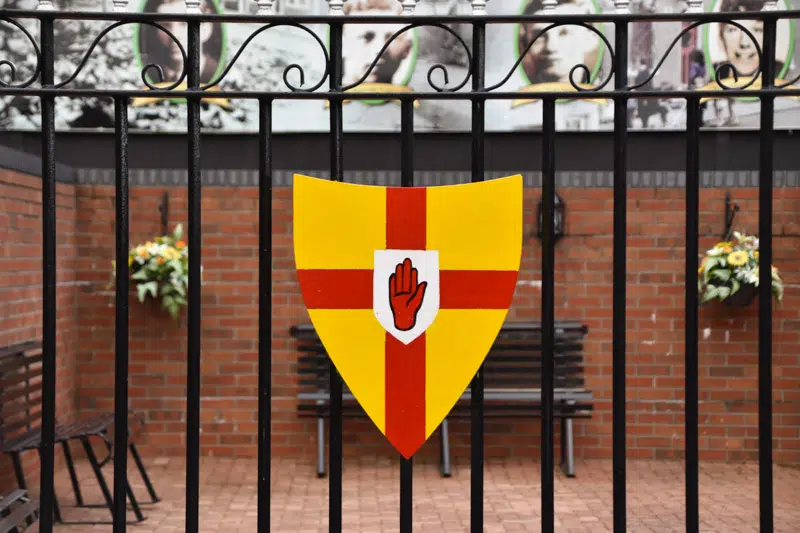

After the church, we moved on to the Clonard Martyrs Memorial, a small red-bricked, gated enclosure and garden dedicated to the fallen volunteers of “C” Company, 2nd Battalion, Belfast Brigade of the IRA.
Our guide explained that these types of memorials are erected in public land and built without permission, knowing that the authorities will not do anything about it in an effort to maintain the peace.
Crossing Communities
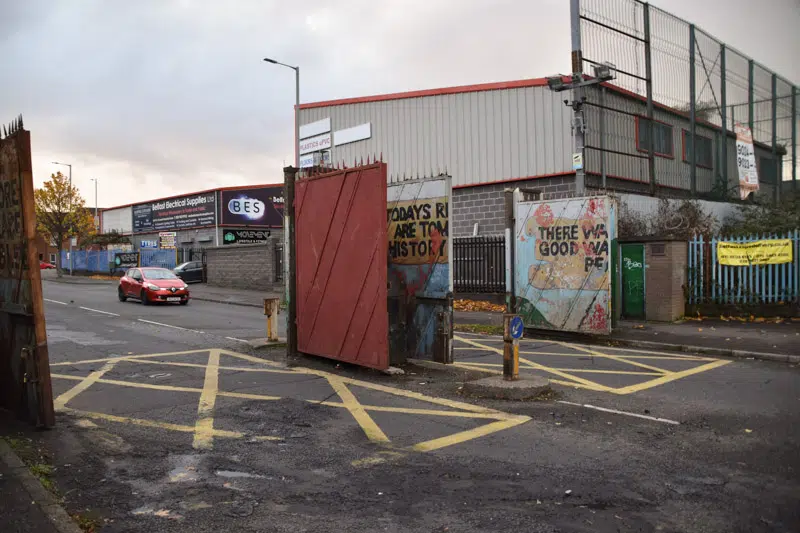
We made our ay from Springfield Road onto Lanark Way which separates it from the loyalist Shankhill Road. Here we crossed through heavy mechanised iron and concrete gates that close each night as with the others. We learned that there had been some rioting and petrol bombs thrown at police at this exact spot the previous night (you can read the news report here).
Once through the gates, we met up with our second tour guide, a loyalist ex-prisoner from the Shankhill Road. Our republican guide exchanged pleasantries with our new guide and I managed to get a photograph of them standing together (with permission of course). I was going to jokingly suggest they give each other a kiss, but thought better of it!
From what I could gather, our new guide seemed to be a former member of the UVF, the Ulster Volunteer Force, a loyalist paramilitary group. He was decked out in blue and white sportswear with a mop of grey hair and a thick Ulster accent.
Belfast Mural Tours – The Peace Lines

We left the dividing gates on Lanark Way and made our way onto Cupar way, which runs adjacent to the peace lines. You can see three distinct sections; the concrete bottom, and then two metal mesh layers that were later added to stop petrol bombs and missiles from being hurled over.
The bottom section of the wall was covered in graffiti, a lot of which has been added by tourists.
The Shankhill Road
The guide led us through a housing estate and out onto the Shankhill Road. We passed houses decked out in Union Jack flags and poppies (it was close to remembrance Sunday) before coming to the Rangers Supporters Club, an outfit for fans of Glasgow Rangers Football Club.
Our guide told us that the previous day, a car with Irish number plates had been torched right outside the club and showed us pictures of the burned-out car from his phone. You can read the news story here.
UVF Murals
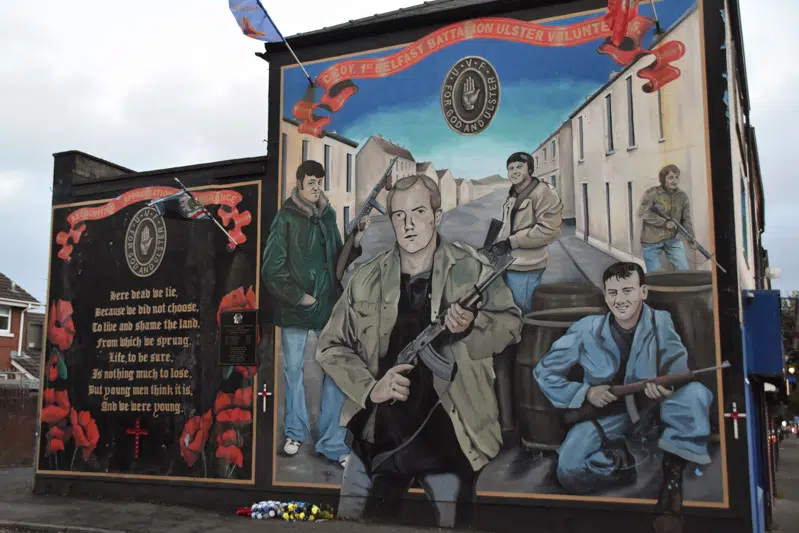
The first loyalist mural we saw was a large painting on the gable end of a row of houses depicting five men carrying large, automatic weapons. The five men were all members of UVF – C COY from West Belfast.
Next, we visited the site of a former fish and chip shop that had been bombed by the IRA on 23rd October 1993. The blast killed ten people, including the bomber, a member of the UDA and eight protestant civilians, including two children.
IRA Victims Memorial
Our guide then explained that we would be visiting a memorial to the victims of the IRA and that behind the memorial was an enclosure with a lot of graphic photographs. The pictures displayed victims of various bomb blasts and so forth. He warned that the pictures were not for the faint of heart and that we were free to view or pass it by as we wished.
I didn’t notice anyone stay outside and everyone entered the area behind the memorial. As we had been warned, there were many graphic pictures detailing the devastating effects of IRA bombs.
There were also many news headlines and what can only be described as propaganda. One piece that sticks in my mind is a headline screaming “ISIS and IRA are No Different!” or something along those lines.
It was a stark contrast to the memorials across the fence and I can’t help but feeling it was not particularly respectful of the victims.

Walking back into central Belfast
The tour ends on the Shankhill Road and it’s a ten-minute walk back into the centre of Belfast.
I can highly recommend this as one of the best Belfast mural tours thanks to the unique perspectives given by each tour guide.
If you’re looking for places to stay in Belfast check out this guide to the best places to stay in Belfast.
Want to see more? You can also see these Derry murals on a trip around the Bogside in Northern Ireland’s second city.
Check out my guides on getting to an from Belfast without flying:
Ferry from Liverpool to Belfast
Ferry from Belfast to Liverpool
Belfast Mural Tour FAQs
You can see murals in Belfast around the Falls Road and Shankhill Road areas. There are also some non-political murals in the city centre. You can either wlk around on your own or take one of the many tours on offer.
Belfast Mural tours range from one-hour taxi tours to three-hour walking tours. The main political and mural tour lasts for three hours (half on the Republican side and half on the Loyalist side).
There are over 2,000 murals across Northern Ireland with most in Belfast and Derry. In Belfast there are around 300 well-preserved murals and many more in differing stages of decay.
Belfast black cab tours cost from £32.50 upwards.
It’s possible to walk the murals in Belfast and both the Republican and Loyalist murals are within walking distance of the city centre. Head to the Falls Road and Shankhill Road to see the most famous murals in the city.
The mural of Bobby Sands is arguably the most famous mural in Belfast. You can see this mural on the Falls Road on the walls of the Sinn Fein HQ.
Conclusion
Whichever of the Belfast mural tours you choose, you will be sure to learn a lot about one of Europe’s bloodiest conflicts. However, as with places like Bosnia, Belfast and Northern Ireland, in general, are great destinations in and of themselves regardless of their troubled past. Book your tour today.

About the author:
Steve Rohan is a writer from Essex, England. He has traveled to over 60 countries, lived in Armenia, China and Hong Kong, and is now living the digital nomad life on the road.
Steve prefers “slow travel” and has covered much of the world by train, bus and boat. He has been interviewed multiple times by the BBC and recently featured in the documentary Scariest Places in the World. See the About page for more info.
Where I am now: Yerevan, Armenia 🇦🇲

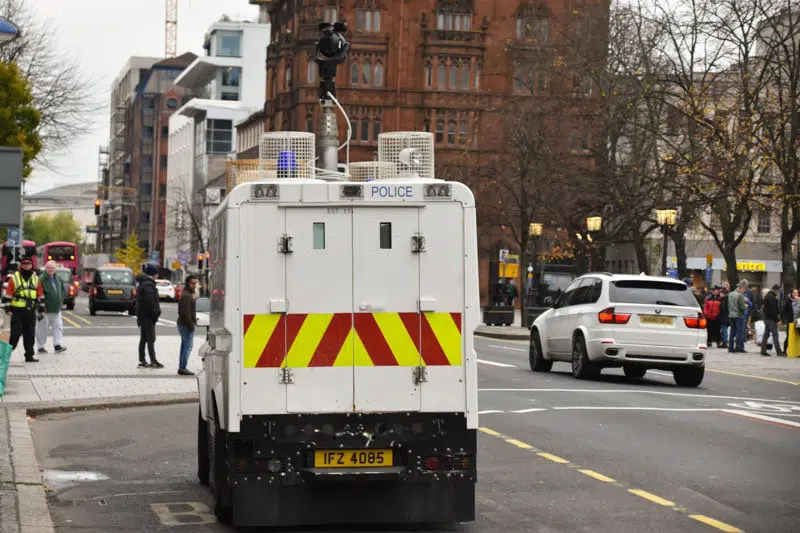


So is it not safe to walk around the various estates of Belfast, Derry/Londonderry, and other places in Northern Ireland taking pictures of the various paramilitary murals with my parents during the day?
I really want to see the paramilitary murals and peace lines before they’re gone. I don’t want to get hurt though. Obviously the tour guide can’t show my parents and I all the murals that I want to see.
Do you think my parents and I would be safe walking around the various estates taking pictures of the murals during the day?
Also, when do you think is the best time to go to Northern Ireland? Everything I read says something different. I want to go as soon as possible, but I don’t want to be freezing or drenched in rain. Some things say June and August is the best time to go. Other things say May to October.
I also don’t want to go during Marching Season. I don’t want to miss any murals that are on closed off areas due to parades and clashes.
Thank you for your help.
Hi Sam,
I understand your concerns, and that is exactly why I did this tour, so that I wouldn’t be walking around the estates on my own snapping pictures. It’s fine to walk around the Shankhill and Falls roads during the day, where the Peace Lines and a lot of the murals are. I personally wouldn’t wander round the estates on my own, but I think during the day you’re unlikely to encounter any trouble.
I went in October last year and the weather was so/so. Rained for some of the time, but it wasn’t cold. I’d try and go as soon as possible if I were you. Spetmeber should be quite pleasant.
Best wishes,
Steve
Fantastic Read, thanks for sharing